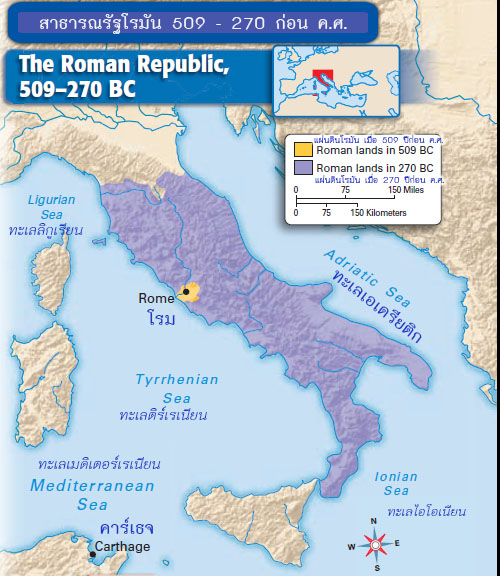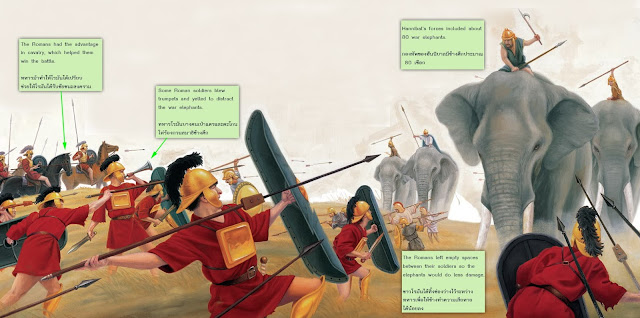The
Late Republic
Growth
of Territory and Trade
After
about 400 BC the Roman Republic grew quickly, both geographically and economically. Within 200 years the Roman army had conquered
nearly all of Italy. Meanwhile Roman traders had begun to ship goods back and forth around the
Mediterranean in search of new products and wealth.
Growth of Territory
Roman territory grew
mainly in response to outside threats. In about
387 BC a people called the Gauls attacked Rome and took over
the city. The Romans had to give the Gauls a huge amount of gold to leave the city.
|
สาธารณรัฐยุคต่อมา
การขยายตัวของอาณาเขตและการค้าขาย
หลังจากประมาณ 400 ก่อนคริสตกาล
สาธารณรัฐโรมันเจริญรุ่งเรืองอย่างรวดเร็ว ทั้งด้านภูมิศาสตร์และด้านเศรษฐกิจ ภายใน
200 ปี กองทัพโรมันได้พิชิตอิตาลีได้เกือบทั้งหมด
ในขณะที่พ่อค้าชาวโรมันเพิ่มขนสินค้าทางเรือกลับไปกลับมารอบ ๆ
ทะเลเมดิเตอร์เรเนียนเพื่อแสวงหาผลิตภัณฑ์และความมั่งคั่งใหม่ ๆ
การขยายตัวของดินแดน
อาณาเขตของโรมันขยายตัวส่วนใหญ่เพื่อตอบสนองต่อภัยคุกคามจากภายนอก
เมื่อประมาณ 387 ปี ก่อนคริสตกาล ผู้คนที่เรียกขานกันว่าชาวกอลได้โจมตีกรุงโรมและยึดครองเมือง
ชาวโรมันต้องสละทองคำจำนวนมหึมาให้กับชาวกอลเพื่อหนีออกไปจากเมือง
|
|
Rome Grows Beyond
Italy
As Rome’s
power grew other countries came to see the Romans as a
threat to their own power and declared war on them. In the end the Romans defeated their opponents, and Rome gained territory throughout
the Mediterranean.
The Punic Wars
The fiercest of the
wars Rome fought were the Punic Wars, a series of wars against Carthage, a city in northern Africa. The
word Punic means “Phoenician” in Latin. The Phoenicians were an ancient
civilization that had built the city of Carthage.
Rome and Carthage
went to war three times between 264 and 146 BC. The wars began when Carthage sent its
armies to Sicily, an island just southwest of Italy. In response, the Romans also sent an
army to the island. Before long,
war broke out between them. After
almost 20 years of fighting, the Romans forced their
enemies out and took control of Sicily.
In 218 BC Carthage tried to attack
Rome itself. An army led by the
brilliant general Hannibal set out for Rome. Although he forced the Romans right to
the edge of defeat, Hannibal was never able to capture Rome itself. In the meantime, the Romans sent an army to attack Carthage. Hannibal rushed home to defend his city, but his troops
were defeated at Zama in the battle illustrated below.
By the 140s BC many senators had grown alarmed that Carthage was growing powerful
again. They convinced Rome’s consuls to declare war on Carthage, and once
again the Romans sent an army to Africa and destroyed
Carthage. After this victory, the
Romans burned the city, killed most of its people, and
sold the rest of the people into slavery. They
also took control of northern Africa.
|
กรุงโรมเจริญรุ่งเรืองกว่าอิตาลี
ในขณะที่อำนาจของโรมเจริญรุ่งเรือง
ประเทศอื่น ๆ ก็มองเห็นว่าชาวโรมันเป็นภัยคุกคามต่ออำนาจของตนเองและได้ประกาศสงครามกับชาวโรมัน
ในที่สุด ชาวโรมันก็พิชิตศัตรูของพวกเขา
และโรมก็ได้อาณาเขตทั่วทะเลเมดิเตอร์เรเนียน
สงครามพิวนิค
สงครามที่ต่อสู้กันดุเดือดที่สุดของกรุงโรม
คือ สงครามพิวนิค เป็นการทำสงครามเป็นชุด ๆ กับคาร์เธจ
ซึ่งเป็นเมืองในตอนเหนือของแอฟริกา คำว่า พิวนิค หมายความว่า “ชาวฟินิเชีย” ในภาษาละติน ฟินิเซียเป็นอารยธรรมโบราณที่สร้างเมืองคาร์เธจ
โรมและคาร์เธจทำสงครามกัน
3 ครั้ง ระหว่าง 264 – 146 ปีก่อนคริสตกาล สงครามเริ่มขึ้นเมื่อคาร์เธจส่งกองทัพไปยังเกาะซิซิลี ซึ่งเป็นเกาะที่อยู่ทางตะวันตกเฉียงใต้ของอิตาลี
ชาวโรมันตอบโต้ด้วยการส่งกองทัพไปยังเกาะนั้นด้วยเช่นกัน
ในไม่ช้า สงครามระหว่างสองเมืองนั้นก็ระเบิดขึ้น หลังจากต่อสู้กันเป็นเวลาเกือบ
20 ปี โรมันก็ขับไล่ศัตรูออกไปและเข้าควบคุมเกาะซิซิลี
เมื่อ 218 ก่อนคริสตกาล คาร์เธจพยายามต่อสู้กับกรุงโรมด้วยตนเอง แม่ทัพฮันนิบาลผู้เฉลียวฉลาดได้นำกองทัพออกไปต่อสู้กับโรม แม้ว่าฮันนิบาลจะบีบบังคับให้ชาวโรมันเกิดความพ่ายแพ้ เขาก็ไม่เคยยึดกรุงได้เลย ในระหว่างนี้ ชาวโรมันได้ส่งกองทัพไปโจมตีคาร์เธจ ฮันนิบาลได้เร่งรีบกลับไปยังบ้านเกิดเพื่อป้องกันเมืองของตนเอง แต่กองทัพของเขาถูกโจมตีจนพ่ายแพ้ที่ซามา ดังภาพวาดสงครามด้านล่าง
ประมาณทศวรรษที่
140 ก่อนคริสตกาล วุฒิสมาชิกหลายคนเกิดความตื่นตระหนกว่า คาร์เธจกำลังจะเรืองอำนาจขึ้นอีกครั้ง
พวกเขาโน้มน้าวกงสุลของโรมให้ประกาศสงครามกับคาร์เธจ โรมันจึงได้ส่งกองทัพไปยังแอฟริกาและทำลายคาร์เธจอีกครั้ง
ภายหลังชัยชนะครั้งนี้ โรมันได้เผาเมือง ฆ่าประชาชนเกือบทั้งหมด
และขายประชาชนที่เหลือเป็นทาส นอกจากนี้ยังได้ยึดครองตอนเหนือแอฟริกาด้วย
|
Rome Battles Carthage
During
the Second Punic War, Hannibal invaded Italy. But Rome’s leaders sent
an army under their general Scipio to attack Carthage itself, forcing
Hannibal to return and defend his city. The
two generals met at Zama, where Scipio defeated Hannibal’s army in the last great battle of the
Second Punic War.
|
โรมทำสงครามกับคาร์เธจ
ในช่วงสงครามพิวนิคครั้งที่สอง ฮันนิบาลได้บุกอิตาลี
แต่ผู้นำกรุงโรมได้ส่งกองทัพภายใต้การนำของแม่ทัพสกิปิโอไปโจมตีตัวเมืองคาร์เธจ เป็นการบังคับให้ฮันนิบาลกลับไปป้องกันเมือง
แม่ทัพทั้งสองได้ประจันหน้ากันที่ซามา ณ ที่นั่นแม่ทัพสกิปิโอได้พิชิตกองทัพของฮันนิบาลจนพ่ายแพ้ในมหาสงครามพิวนิคครั้งที่สองอันเป็นครั้งสุดท้าย
|
|
Later Expansion
During the Punic
Wars, Rome took control of Sicily, Corsica, Spain, and
North Africa. As a result, Rome controlled most of the western Mediterranean region.
In the years that
followed, Roman legions marched north and east as well. In the 120s Rome conquered the southern part
of Gaul. By that time, Rome had also conquered
Greece and parts of Asia.
|
การขยายดินแดนในยุคต่อมา
ในระหว่างสงครามพิวนิค
โรมได้ยึดครองเกาะซิซิลี เกาะคอร์ซิกา สเปน และแอฟริกาตอนเหนือ
เป็นผลให้โรมยึดครองภูมิภาคทะเลเมดิเตอร์เรเนียนด้านตะวันตกเป็นส่วนใหญ่
ในปีต่อมา
กองทหารโรมันได้ยาตราทัพขึ้นไปทางเหนือและทางตะวันออกด้วย เมื่อทศวรรษที่ 120
โรมได้พิชิตด้านทิศใต้ของกอล ณ เวลานั้น
โรมก็ได้พิชิตกรีซและดินแดนบางส่วนของเอเชียด้วย
|
Crises Strike the
Republic
As the Romans’ territory grew, problems arose in the
republic. Rich citizens were getting
richer, and many leaders feared that violence would
erupt between rich and poor.
Tiberius and Gaius
Gracchus
Among the first
leaders to address Rome’s problems
were brothers named Tiberius and Gaius Gracchus. Both served as tribunes.
Tiberius, who took
office in 133 BC, wanted to create farms for poor Romans. The purpose of these farms was to keep the
poor citizens happy and prevent rebellions. Tiberius
wanted to create his farms on public land that wealthy
citizens had illegally taken over. The
public supported this idea, but the wealthy citizens
opposed it. Conflict over the idea
led to riots in the city, during which Tiberius was
killed.
A few years later Gaius also tried
to create new farms. He also began
to sell food cheaply to Rome’s poor
citizens. Like his brother, Gaius
angered many powerful Romans and was killed for his
ideas.
The violent deaths of the Gracchus brothers changed Roman politics. From that time on people saw violence as a political
weapon. They often attacked leaders
with whom they disagreed.
Marius and Sulla
In the late 100s BC
another social change nearly led to the end of the
republic. In 107 BC the Roman army desperately needed more troops. In response, a
consul named Gaius Marius encouraged poor people to join the army. Before, only people who owned property had been allowed
to join. As a result of this change, thousands
of poor and unemployed citizens joined Rome’s army.
Because Marius was a good general,
his troops were more loyal to him than they were to Rome. The army’s
support gave Marius great political power.
Following his example, other ambitious
politicians also sought their armies’ support.
One such politician, Lucius
Cornelius Sulla, became consul
in 88 BC. Sulla soon came into
conflict with Marius, a conflict that led to a civil war
in Rome. A civil war is a war
between citizens of the same country. In the end Sulla
defeated Marius. He later named
himself dictator and used his power to punish his
enemies.
Spartacus
Not long after Sulla
died, another crisis arose to challenge Rome’s leaders. Thousands of
slaves led by a former gladiator, Spartacus, rose
up and demanded freedom.
Spartacus and his
followers defeated an army sent to stop them and took
over much of southern Italy. Eventually,
though, Spartacus was killed in battle. Without
his leadership, the revolt fell apart.
Victorious, the Romans executed 6,000 rebellious slaves as an example to others who thought about rebelling. The rebellion was over, but the republic’s problems were not. |
วิกฤตการณ์เข้าจู่โจมสาธารณรัฐ
ในขณะที่อาณาเขตของโรมขยายออกไป
ก็มีปัญหาเกิดขึ้นในสาธารณรัฐ ประชากรผู้มีความร่ำรวยก็ร่ำรวยยิ่งขึ้น
และผู้นำหลายคนกลัวว่า ความรุนแรงอาจจะปะทุขึ้นระหว่างคนรวยและคนจน
ทิเบริอุสและไกอุส กราคคุส
ในจำนวนผู้นำพวกแรกที่จัดการกับปัญหาของโรมก็มีพี่น้องนามว่า
ทิเบริอุสและไกอุส กราคคุส ทั้งสองทำหน้าที่เป็นทริบูนส์
(เจ้าหน้าที่ผู้ป้องกันเสรีภาพของประชาชน)
ทิเบริอุส ผู้ที่ได้เริ่มปฏิบัติหน้าที่ที่ได้รับมอบหมายเมื่อ 133
ปีก่อนคริสตกาล ต้องการจะสร้างไร่นาให้กับชาวโรมันผู้ยากจน วัตถุประสงค์ของไร่นาเหล่านี้คือทำให้ประชากรผู้ยากไร้มีความสุขและป้องกันการก่อกบฏ
ทิเบริอุสต้องการสร้างไร่นาของตนเองบนที่ดินสาธารณะที่ประชากรผู้ร่ำรวยยึดครองโดยผิดกฎหมาย
สาธารณชนได้สนับสนุนแนวความคิดนี้ แต่ประชากรผู้ร่ำรวยได้คัดค้านแนวความคิดนี้ ความคัดแย้งที่มีต่อแนวความคิดนั้นนำไปสู่การก่อจลาจลในเมือง
ซึ่งเป็นเหตุให้ทิเบริอุสถูกสังหารในช่วงนั้น
สองสามปีต่อมาไกอุสก็พยายามสร้างไร่นาแห่งใหม่ขึ้นเช่นเดียวกัน นอกจากนั้นเขายังได้เริ่มจำหน่ายอาหารถูกให้กับประชากรผู้ยากไร้
ไกอุสโกรธชาวโรมันผู้มีอิทธิพลจำนวนมากและถูกสังหารเนื่องจากแนวความคิดของเขา
ความตายอันเกิดจากความรุนแรงของสองพี่น้องกราคคุสได้เปลี่ยนแปลงการเมืองของโรมัน
นับตั้งแต่นั้นมา ประชาชนก็มองความรุนแรงเป็นอาวุธทางการเมือง พวกเขาได้โจมตีเหล่าผู้นำที่พวกเขาไม่เห็นด้วยอยู่เป็นประจำ
เมื่อปลายศตวรรษที่ 100 ก่อนคริสตกาล
การเปลี่ยนแปลงทางการเมืองอีกครั้งหนึ่งเกือบนำไปสู่การสิ้นสุดของสาธารณรัฐ เมื่อ
107 ปีก่อนคริสตกาล กองทัพโรมัน มีความต้องการกองทหารมากขึ้นเต็มที่ เพื่อตอบสนองความต้องการนั้น
กงสุลนามว่า ไกอุส มาริอุส ก็กระตุ้นให้ประชาชนผู้ยากไร้เข้าสมทบกับกองทัพ
แต่ก่อนผู้คนที่เป็นเจ้าของทรัพย์สมบัติเท่านั้นจึงได้รับอนุญาตให้เข้าร่วม ด้วยสาเหตุแห่งการเปลี่ยนแปลงครั้งนี้
คนยากไร้หลายพันคนและประชากรผู้ว่างงานก็เข้าร่วมกองทัพของโรม
เนื่องจากมาริอุสเป็นแม่ทัพผู้มีน้ำใจ
กองทหารของเขาจึงจงรักภักดีต่อเขามากกว่ากรุงโรม การสนับสนุนของกองทัพทำให้มาริอุสมีอำนาจทางการเมืองอันยิ่งใหญ่
นักการเมืองผู้ทะเยอทะยานคนอื่น ๆ ยังได้แสวงหาความสนับสนุนจากกองทัพของตนเอง ด้วยการดำเนินรอยตามอย่างมาริอุส
นักการเมืองแบบนั้นอีกคนหนึ่ง
คือ ลูซิอุส คอร์เนลิอุส ซูลลา
กลายเป็นกงสุลเมื่อ 88 ปีก่อนคริสตกาล ในไม่ช้า ซูลลาก็เกิดความขัดแย้งกับมาริอุสเป็นความขัดแย้งที่นำไปสู่สงครามกลางเมืองในกรุงโรม
สงครามกลางเมืองคือสงครามระหว่างประชาชนของประเทศเดียวกัน ในที่สุด ซูลลาก็ชนะมาริอุสต่อมาเขาตั้งฉายานามตัวเองเป็นนักเผด็จการและใช้อำนาจลงโทษกองทัพของตนเอง
สปาร์ตากุส
อีกไม่นานภายหลังจากซูลลาเสียชีวิต
วิกฤตการณ์อีกครั้งหนึ่งก็อุบัติขึ้นท้าทายผู้นำของโรม ทาสหลายพันคนนำโดยนักต่อสู้ยุคแรก
คือ สปาร์ตากุส ลุกฮือขึ้นต่อต้านและเรียกร้องอิสรภาพ
สปาร์ตากุสและสานุศิษย์ของเขาพิชิตกองทัพที่ส่งไปยับยั้งพวกเขาและยึดอิตาลีตอนใต้ได้เป็นจำนวนมาก
ถึงกระนั้น ในที่สุด สปาร์ตากุสก็ถูกสังหารในสงคราม เมื่อปราศจากภาวะผู้นำของเขา
การปฏิวัติก็ล้มเหลว
ชาวโรมันที่ได้รับชัยชนะก็ประหารเหล่าทาสที่เป็นกบฏ
6,000 คน เพื่อเป็นตัวอย่างแก่คนอื่น ๆ ที่คิดจะก่อการกบฏ การกบฏได้สิ้นสุดลง
แต่ปัญหาของสาธารณรัฐก็ไม่สิ้นสุด
|
|
|
|
|
||
|
BIOGRAPHY
Hannibal (247–183
BC)
Many historians
consider Hannibal to be one of the greatest generals of
the ancient world. From an early
age, he hated Rome. In 218 BC he
began the Second Punic War by attacking one of Rome’s allies in Spain. After
the war he became the leader of Carthage, but later he
was forced by the Romans to flee the city. He went to
Asia and joined with a king fighting the Romans there. The king was defeated, and Hannibal
killed himself so that he wouldn’t
become a Roman prisoner.
|
อัตชีวประวัติ
ฮันนิบาล (247 – 183 ปีก่อนคริสตกาล)
นักประวัติศาสตร์จำนวนมากถือว่าฮันนิบาลเป็นแม่ทัพผู้ยิ่งใหญ่ที่สุดคนหนึ่งในโลกโบราณ
เขาเกลียดโรมมาตั้งแต่เยาว์วัย เมื่อ 218 ปีก่อนคริสตกาล
เขาเริ่มก่อสงครามพิวนิคครั้งที่สอง ด้วยการโจมตีสัมพันธมิตรของโรมในสเปน หลังสิ้นสุดสงครามเขาเป็นผู้นำคาร์เธจ
แต่ต่อมาเขาถูกชาวโรมันบังคับให้หนีออกจากเมือง จึงได้เดินทางไปยังเอเชียและสมทบกับกษัตริย์ต่อสู้กับชาวโรมัน
ณ ที่นั่น กษัตริย์ได้รับความพ่ายแพ้
และฮันนิบาลก็ฆ่าตัวตายเพื่อตัวเองจะได้ไม่ตกเป็นเฉลยของโรมัน
|
|
Lucius Cornelius
Sulla (138–78 BC)
Although the two
eventually became enemies, Sulla learned much of what he knew about military
affairs from Gaius Marius. He had been an assistant to Marius before he
became consul. Sulla changed Rome’s government forever when he became
dictator, but he actually had many traditional ideas. For example, he
believed the Senate should be the main ruling group in Rome, and he increased
its power during his rule.
|
ลูซิอุส คอร์เนลิอุส ซูลลา (138 – 78 ปีก่อนคริสตกาล)
แม้ว่าในที่สุดทั้งคู่จะกลายเป็นศัตรูกัน
ซูลลาก็ได้เรียนรู้เกี่ยวกับกิจการทางด้านทหารจากไกอุส มาริอุสมากมาย เขาเป็นผู้ช่วยมาริอุสก่อนที่จะเป็นกงสุล
ซูลลาได้เปลี่ยนแปลงการปกครองของโรมชั่วกาลนานในขณะที่เขาเป็นนักปกครองเผด็จการ
แต่โดยแท้จริงเขามีแนวความคิดแบบดั้งเดิมมากมาย ยกตัวอย่างเช่น
เขาเชื่อว่าวุฒิสภาควรจะเป็นกลุ่มนักปกครองกลุ่มหลักในกรุงโรม และเขาได้เพิ่มอำนาจของวุฒิสภาในช่วงที่เขาปกครอง
|






